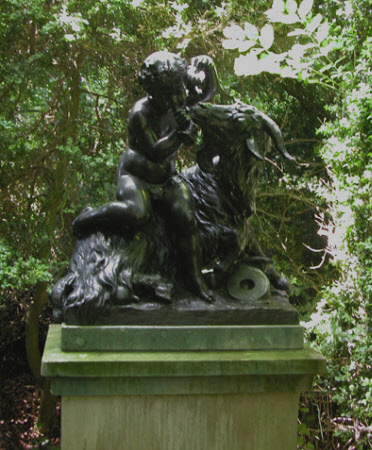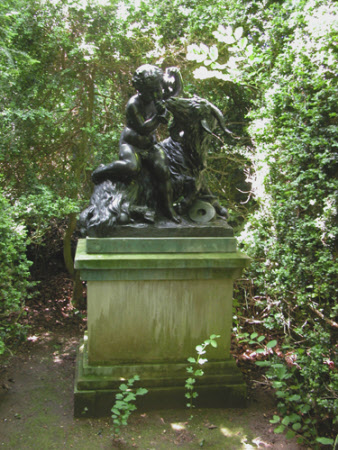Bacchic putto with goat
probably French School
Category
Art / Sculpture
Date
c. 1850 - c. 1925
Materials
Bronze
Measurements
890 x 850 x 460 mm
Place of origin
France
Order this imageCollection
Anglesey Abbey, Cambridgeshire
NT 515164
Summary
Bronze, Bacchic putto with goat, probably French School, c. 1850-1925. A full-size group cast in bronze of a Bacchic putto sitting on a goat. The infant, nude and crowned with grape vine, blows a bovid horn and holds up a vine leaf in his proper left hand. The horned long-haired goat twists its necks to look towards him, trying to eat the vine leaf. A pair of cymbals can be seen between the goat’s forelegs. Probably a 19th century French cast inspired by François Boucher (1703-70). With black lacquer; mounted on a rectangular limestone plinth.
Full description
As members of Bacchus’ retinue, putti were often figured in classical depictions of Bacchic rites, jostling over grapes or riding or dragging a goat towards the sacrificial altar. Various artists interpreted this motif in the post-classical world, notably Nicholas Poussin (1594-1665) in his Bacchanalia of Putti, two panels painted in 1626 when the artist was working in Rome with the Flemish sculptor Francois Duquesnoy (1597-1643). These works, now in the Palazzo Barberini, were directly influenced by the Bacchanals of Titian in the Palazzo Aldobrandini and Villa Ludovisi. Duquesnoy’s all’antica bas-relief ‘Children playing with a goat’ was carved in 1630 for the Villa Pamphilj and is now in the Palazzo Spada. It was copied in grisaille by several artists working in the style of Jakob de Wit (inv.no. 07.225.257, Metropolitan Museum of Art, New York). Inspiration for the relief is believed to have come from Virgil’s second Georgic which warns against the threat of ‘pestering’ goats hungry for the tender young leaves growing on grape vines (Lingo 2007, p. 51 and Virgil, Georgics, II). ‘For no offence but this’, Virgil writes, were goats sacrificed at the altar of Bacchus. In the 18th century François Boucher (1703-70) returned to the motif in one of his earliest autonomous compositions of putti: Putti Playing with a Goat (private collection) as an allegory of Autumn. Several of Boucher’s designs were modelled for the French royal porcelain factory at Vincennes by Louis-Félix Delarue, a draughtsman and sculptor specialising in Bacchic putti before Clodion took up the mantle later in the century (inv. nos. 1983.72.12, 59.87.1 and 59.24a, Metropolitan Museum of Art, New York). The motif continued to be popular throughout the 19th century; see, for example, the Children with goat model by Albert-Ernest Carrier-Belleuse and NT 1399563, Guillaume Denière after Clodion. Bronze castings in life-size were produced predominantly from the mid-19th century in France and Italy (see Davis 1991, pp. 131-2). Alice Rylance-Watson 2019
Provenance
Bequeathed to the National Trust by Huttleston Rogers Broughton, 1st Lord Fairhaven (1896-1966) with the house and the rest of the contents.
Credit line
Anglesey Abbey, The Fairhaven Collection (The National Trust)
Makers and roles
probably French School, sculptor
References
Lingo 2007: Estelle Lingo, François Duquesnoy and the Greek Ideal, New Haven and London 2007 Davis 1991: John Davis, Antique Garden Ornament, 300 years of creativity: Artists, manufacturers & materials, Woodbridge 1991, p. 131-2. Roper 1964: Lanning Roper, The Gardens of Anglesey Abbey, Cambridgeshire. The Home of Lord Fairhaven, London 1964, p. 40, pl. 16. Christie, Manson & Woods 1971: The National Trust, Anglesey Abbey, Cambridge. Inventory: Furniture, Textiles, Porcelain, Bronzes, Sculpture and Garden Ornaments’, 1971, p. 173.

